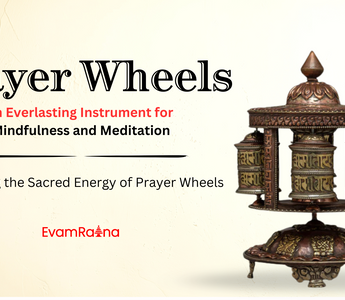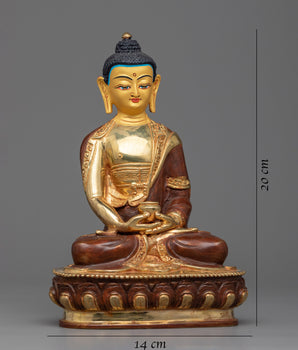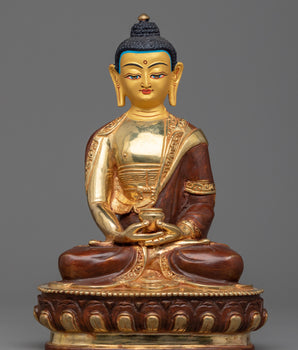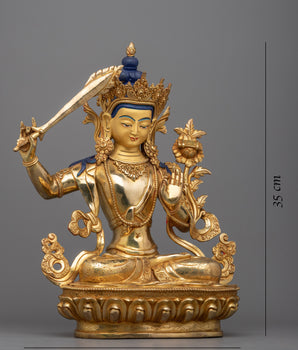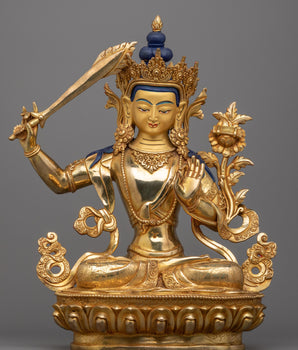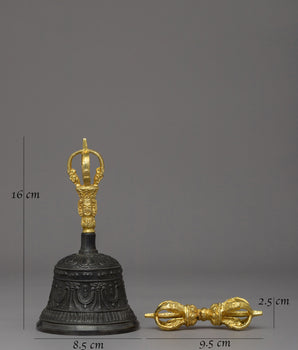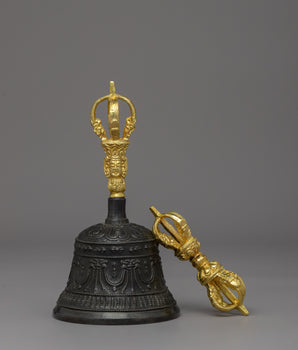Harnessing the Sacred Energy of Prayer Wheels
Prayer wheels are not just ceremonial objects in the Himalayan areas; they are also essential for an ancient spiritual practice that helps the devotee to establish a link with the divine. People use prayer wheels alongside mantras that include "Om Mani Padme Hum" as they turn prayer wheels to accumulate blessings while creating positive energy.
People who seek inner peace along with spiritual growth and heightened awareness have been fascinated by the power of prayer wheels for numerous years.In Tibetan Buddhism, the sacred tools are more than just decorations; they help people gain merit by focusing on decisions and showing devotion through their bodies. The complete blog delves into the historical development along with the sacred importance and functional advantages of prayer wheels. The guide also details different forms of prayer wheels and expert rituals that create sacred energy.
How Prayer Wheels Help Accumulate Merits Every Day

Using prayer wheels enables people to transform ordinary activities into effective spiritual practices, which help build their religious merits daily. Spiritual chants starting with "Om Mani Padme Hum" are recited during every wheel rotation, which expands the positive power from each revolution. Entry to enlightenment through Tibetan Buddhism primarily depends on the accumulation of merit. When practitioners use prayer wheels, they convert ordinary movements into deep meditation through the act of focused, purposeful attention. According to Tibetan Buddhist beliefs, the wheel's deliberate rotation creates positive energy, which extends out to bless every living being at the same time that it cleanses spiritual harm. Every rotation of the prayer wheel builds merit as it establishes a direct connection between pointful daily practice and personal transformation to help practitioners remember their spiritual growth commitment.
The Power of Mantra Recitation
A prayer wheel functions through the written chant inscribed on its surface. Multiple millions of people throughout the world repeat the popular mantra "Om Mani Padme Hum" because it embodies compassion. Believers in this practice consider that the turning motion spreads written mantras throughout a wide area to cause blessings to multiply. The continuous rotation with chanting action produces a rise in spiritual energy according to religious teachings, which brings small improvements to each devotee with every turn.
Daily activities acquire sacred religious power when a person practices deliberate use of prayer wheels. People use wheel spin purposefully to demonstrate how ordinary tasks become sacred by this process. Every sincere action within Tibetan Buddhist belief generates good karma. People who make prayer wheel spinning a constant practice in their daily routines generate spiritual merits through which they destroy bad karma and find enlightenment.
The main attractive feature of Mani wheels lies in their ability to create advantages for living beings and nature. The rotation of the wheel leads people to believe that its blessings affect universal lives beyond the person who spins it. The spiritual advancement of each person seamlessly blends with social welfare, according to Buddhist philosophy, through this shared symbolic advantage.
Different Kinds of Prayer Wheels
Each type of prayer wheel maintains its spiritual value while accommodating various rituals and ways of living. Most people are familiar with the traditional Tibetan prayer wheel, which is usually a cylindrical object with holy mantras engraved on it. Such objects serve both monasteries and temples as instruments for creating communal blessings and merits. Portable prayer wheels provide flexibility to practice meditation on the go because they are easily portable. The miniaturized dimension of these wheels preserves the complete spiritual benefits that belong to the traditional versions. Finely decorated prayer wheels, made from precious materials and intricate carvings, serve the decoration and memory function. Such wheels function as both sacred symbols of long heritage and decorative home items. Prayer wheel meditation delivers timeless benefits since digital prayer wheels unite advanced technology with conventional spiritual practice to spread its advantages to all people.For instance,
Types of Buddhist Prayer Wheels
The design range of Buddhist prayer wheels extends from small handheld prayer wheels to big prominent wheels. There exist prayer wheels with different designs, including the hand-held and tabletop formats. Massive wheels reach heights of eight to twelve feet while having diameters that range from five to six feet. The function and design of Buddhist prayer wheels create three main categories as follows:

1. Mani wheels: The mani wheel stands as the most commonly used type of Tibetan prayer wheel designed for manual use. The round metal cylinder joins to a handle made either of wood or metal, which enables circular rotation. Small rotations of the cylinder become possible through either its cord system or chain mechanism.
2. Fire wheels: The fire wheel represents a particular prayer wheel that turns autonomously because of electric light and candle heat energy. When the wheel operates, it generates a limpid light that purges wicked karma from all living beings that encounter its transmission.
3. Water wheels: The water wheels are the Tibetan prayer wheels that rotate on their own when water flows. Most people believe that the water that comes into contact with the wheel is blessed. It can purify all living things in rivers, lakes, and eventually the seas.
4. Fixed wheels: Metal wheels are affixed to monasteries in Tibet, Nepal, and other places. Larger monasteries arrange them either separately or in a row. The row of wheels allows pilgrims to move their hands over them.
5. Wind wheel: The Tibetan prayer wheel, known as the wind wheel, spins due to the force of the wind. The wind cleanses the negative karma of the living beings that touch the wheel.
6. Electric dharma wheels: Wheels driven by electric motors are known as electric dharma wheels. Another energy source is electricity. The spinning of these prayer wheels never stops.
These Tibetan prayer wheels are seen in Buddhist monasteries and stupas. Pilgrims recite "Om Mani Padme Hum" while spinning hundreds of these wheels in a clockwise manner. There are hundreds of these wheels at the two most significant Buddhist pilgrimage sites, Swayambhunath and Boudhanath.
The Art and Ritual of Consecration on Prayer Wheels

Consecration, a crucial procedure, transforms a prayer wheel from an ordinary item into a holy tool of devotion. This process imbues the wheel with spiritual energy, enabling it to channel blessings and accumulate merits. Gaining knowledge of the consecration rites provides a deep understanding of the respect and care that are associated with these spiritual instruments.
The act of consecration, which aligns the prayer wheel with divine energy, is more than just a ceremonial ceremony. Each item in Tibetan Buddhism undergoes consecration to fulfill its assigned spiritual purpose. A certified lama or spiritual instructor performs specific rites, chants mantras, and invokes sacred blessings to transform the wheel into a conduit for spiritual merit.
Prayer wheels are traditionally consecrated using a number of intricate rites that can differ from monastery to monastery. The process usually begins with the physical and spiritual cleaning of the wheel. The next phase is the chanting of mantras and the invocation of deities, both of which are intended to direct divine energy into the object. A final blessing, which completes the consecration and permits the prayer wheel to start its holy work, marks the end of the event.
What Are the Spiritual Significance of the Sacred Mantras Found Inside Prayer Wheels?

The inscribed mantras differ from places in text format and even prayers. While most of the prayer wheels are inscribed with a meritorious prayer in general about the universal gods, it is believed that it’s mostly dedicated to the God—Avalokiteshvara Bodhisattva. Numerous carvings of the phrase "Om Mani Padme Hum" adorn the most common type of payer wheel. The Tibetan mantra translates to “Praise/Hail to the Jewel in the Lotus.” These mantras are mostly inscribed in the Tibetan language called the Uchen Script. However, during the Licchavi dynasty, from around 450 to 750 CE, the prayer wheels were also inscribed in Ranjana Lipi (script), Prachalit Lipi and Newa Lipi in Nepal.
People regard the auspicious symbols and mantras inscribed in the prayer wheels to promote prosperity, wisdom, kindness, peace, and strength. Other than that, people found themselves feeling more grounded and relaxed after consciously using it for meditation sessions.
Integrating Prayer Wheels into Daily Mindfulness Practices

Many practitioners incorporate prayer wheels into their daily lives as aids for ongoing mindfulness and meditation, extending their use beyond the hallowed confines of temples and monasteries.
Adding a prayer wheel to your own meditation area can have a profoundly positive impact. Keeping a prayer wheel at home, whether it's a tiny, portable wheel or a large ornamental piece, acts as a daily reminder of your spiritual journey. Establish a special area where you can set the prayer wheel, burn incense, and meditate for a short while. This area could be a tiny altar or a peaceful area in your house. The process of creating a sacred space can serve as a constant focus point for introspection and serve as an anchor for your mindfulness practice.
Sharing the Practice with Others
The benefits of prayer wheel practice go beyond solitary meditation; it can also be done as a communal activity, bringing your local community closer together. You can arrange group sessions with friends, family or fellow practitioners to spend time spinning the prayer wheels and reciting mantras. These gatherings not only enhance the collective merit but also strengthen the bonds of kinship and shared goals. In a time where you still feel isolated, the communal mindfulness practices become the reminder of our interdependence.
The Intersection of Art and Spirituality

Prayer wheels represent an important position at the intersection of artwork, spiritual practice, and cultural heritage. With its delicate ornamentation and meaningful inscriptions, prayer wheels represent rich cultural heritage in terms of artwork, in which each curve and detail holds deep meaning.
The intersection between artwork and spirituality creates an effective dialogue that tests traditional forms of expression, inviting deep reflection. People have used holy images and rich ornamentation to represent the divine character across cultures and centuries. Artistic practice acts as a reflective tool for theological thinking, with rich colors and high skill conveying messages of hope, unification, and transcendence. Religious rituals, such as prayer wheels and temple murals, carefully craft their beauty to align with their holy purpose. Through artwork, awareness and reverence arise, and observation turns into a state of reflection. Spirituality and artwork acknowledge humanity and foster deeper relationships with ourselves and the universe. Engaging and vibrant processes of encounter stimulate individual growth and build community, providing a form of expression for life's mysteries and a constant search for meaning. In overcoming the divide between beauty and deep spirituality, artwork reveals humanity's character.
The Enduring Appeal of Traditional Craftsmanship
Despite contemporary technology and contemporary manifestations of contemporary art, old prayer wheels hold a unique place in the hearts of the faithful. They remain relevant because they distill centuries of tradition and legend into a single tangible artifact. Each prayer wheel, whether laboriously made in a village by a traditional craftsman or mass-produced for global distribution, carries with it resonances of centuries-old ceremonies and a collective memory of a deep heritage of religion.
Preserving Cultural Heritage Through Modern Practice
Today, a campaign is underway to preserve traditional customs and adapt them to modern times. The prayer wheel perfectly aligns with its origins in ancient Tibetan rituals. In a matter of years, the prayer wheel grew in a compatible form with modern practitioner’s requirements. With an awareness of both modernity and traditionalism, practice of prayer wheel continues to be a relevant practice in present times as it did centuries ago, an ever-lasting bridge between our heritage and a guiding principle for our journey through life.
Embracing the Transformative Power of Prayer Wheels

People view the use of prayer wheels as one instrument of change connecting ancient spiritual technologies with modern mindfulness. It is in the intentionality of engagement that transforms the physical spinning of the wheel into moving meditation, cleansing the mind to leave an inner calm and clarity. Every rotation of the wheel, in conjunction with sacred mantras, is believed to cultivate merit by transforming ordinary daily activities into opportunities for spiritual advancement. This practice not only helps the person to convert the negative energies into positive ones but also spreads the blessings within the community to create a ripple effect of healing and compassion. Embracing the transformative power of prayer wheels means embracing change and inner renewal in life, connecting one more deeply with oneself and the universe. In this way, prayer wheels empower practitioners to face the challenges of life through a balanced, centered approach, inviting further personal evolution and a much deeper state of mindfulness.
Imagine your daily interaction with the prayer wheel as a dance—a delicate balance of motion, sound, and intention. Each rotation of the wheel, in addition to its physical nature, symbolizes a turn in the wheel of life. As you rotate the wheel, let your mind wander, focusing on the contemplation of those deep truths. This is a soft, gentle, rhythmic wheel—one that reminds every day is one's chance to get rid of old habits, see things in new ways, and move closer to the manifestation of your highest self.
Final Thoughts: A Legacy of Mindfulness and Meditation
The prayer wheels are something more than ritual objects; they come alive in the continuing centuries of spiritual practice, art, and cultural heritage. It is this transformation of everyday action into sacred rituals—that of changing a wheel's movement into an enlightening journey toward mindfulness and meditation—which keeps their power with them.
Working with prayer wheels offers you the respect of an age-old tradition while actively participating in your spiritual development. Be it the uttering of mantras, the intentional consecration of the wheel, or the participation in community practice, every action taken with the prayer wheel will be an act of investment for a more thoughtful, kind-hearted, and awake life.
May the ever-turning wheel remind you of the eternal cycle of renewal, the continuous flow of positive energy, and the boundless potential for spiritual growth within you as you journey on.
The little prayer wheel provides a sanctuary of mindfulness and meditation in a fragmented and hurried world, serving as a timeless tool that reconnects us to our fundamental essence. Engage in the practice, and let every turn gather merit as the holy rhythm of the prayer wheel leads you down the path toward inner peace and enlightenment.
Through traditional craftsmanship, modern adaptations, and the power of communal and personal practice, the prayer wheel remains an everlasting symbol of hope, resilience, and the transformative power of mindfulness. Let this be your sacred tool of reminder each day—that even the smallest action may be the cause for a huge shift in your consciousness, leading you closer to the ultimate realization of your spiritual journey.
May every revolving wheel bless your path, and may your mind always remain open to the infinity of love, compassion, and inner peace.

